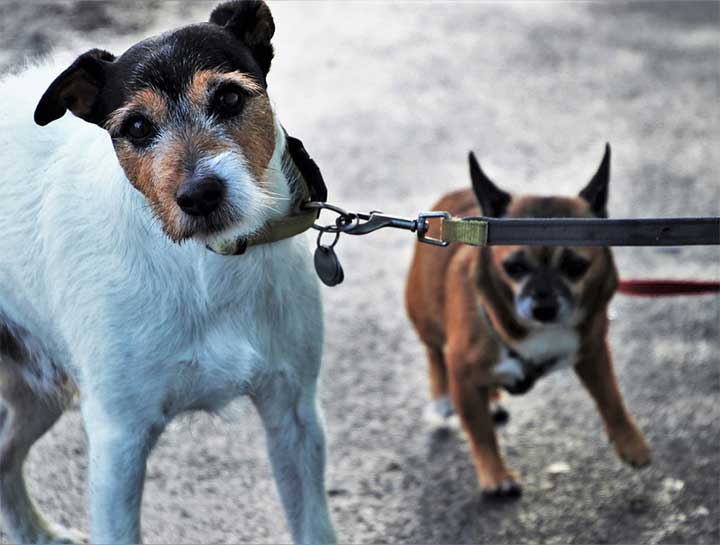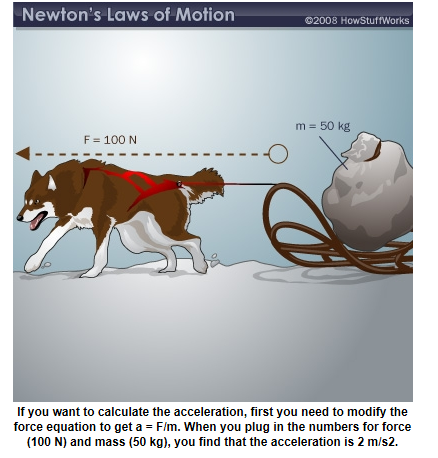Harnessing Your Dog's Power

Taking your dog for a walk is more than just good exercise, it is key to your dog’s mental well-being. Dogs were ‘designed’ as hunting pack animals, which means that they are supposed to spend a lot of time walking from place to place. During these walks, dogs learn about their pack and their neighborhood—who is in charge, what noises are normal and which are to be feared, and they burn off a lot of nervous energy, too.
Unfortunately, many people don’t know how to walk their dog. First and foremost, your dog is supposed to walk at your side. When he is allowed to constantly walk in front of you, this means that he is in charge. Remember, the top dog is the one at the lead of the pack! Dogs who think they are ‘in charge’ tend to have a number of problem behaviors, including housetraining problems and incessant barking.
A good walk begins with a proper leash and collar. At some point, a dog may see something that interests him on the sidewalk—a piece of food, a leaf, or another dog. A well-trained dog will respond to a slight tug on the leash that in turn creates a slight ‘pulling sensation’ on the collar. This pulling sensation should be enough to tell him when he’s at the ‘end of his rope,’ so that he stops pulling and returns to your side.
Choosing a Leash
I prefer a long flat leash—it gives you control and is less likely to cause rope burn (than a cord leash) if you need to give a brisk tug. Also, with a flat leash you don't have to use the handle to hold on to-- in case of emergency, you can grab anywhere on the leash and pull your dog to safety.
I don't care for self-rewinding leashes because they always have tension and pull, and that teaches dogs to ignore the pulling sensation that should be the signal to "get back to the pack." With self-rewinding leashes, dogs quickly become less responsive when you really do want him to come back.
Collar or Harness?
THERE ARE ONLY THREE TIMES WHEN A HARNESS IS APPROPRIATE FOR YOUR DOG—1) IF HE IS PULLING A SLED OR 2) HE IS A HIGHLY TRAINED GUIDE OR ASSISTANCE DOG, OR 3) AN EXISTING HEALTH PROBLEM DEMANDS THAT HE NOT HAVE THE PRESSURE OF A COLLAR PLACED AROUND HIS NECK.

When your dog is at one end of the harness and you are at the other end, this means that your weight is distributed across the dog’s body. A harness allows your dog to have more ‘pulling power’, which means that it is easier for him to cause injury to you—by constantly yanking on your arm and shoulder. Harnesses do not give the proper feedback to your dog—he never gets the message that he’s at the end of the leash because the force of you tugging on the leash never creates the ‘pulling sensation.’
Using a Collar:
When a dog is going for a walk, it is very important for his collar to be positioned high up on his neck—just below his jaw. This will create the feedback of a pulling sensation without choking and stressing your dog.
As training collars, choke chains (it’s more politically correct and accurate to call them “slip chains”) are probably the least understood and most abused collars out there. When a dog is properly trained on a choke chain, he should never need to be choked! In fact, the tightening of the choke chain is supposed to alert him before the choking occurs, so that he decides not to pull on his own. The most common mistakes with choke (slip) chains are that 1) they fit incorrectly (too big or too small) and 2) they are put on backwards—yes, there is a right and a wrong way to put on a choke (slip) chain (and it’s easy to choose the wrong way nearly 100% of the time.) If you insist on using a choke (slip) chain, then read this website for a refresher course–Here’s an excellent YouTube video on the use of slip chains: http://www.youtube.com/watch?v=bo0BKCTncEc
Prong or pinch collars may look like cruel torture devices, but can work well for many dogs. These collars are designed to fit snuggly around (and high up on) the dog’s neck. If there is any ‘wobble’ to the collar, then it isn’t properly fitted. A prong/pinch collar works by tightening evenly around the dog’s neck when he is at the end of his leash. Once again, if a dog is allowed to tug and get ‘pinched’ repeatedly by the collar, then it will lose its effectiveness. A terrific website that covers the prong collar is http://leerburg.com/fit-prong.htm
An interesting hybrid is called the Martingale collar. With a Martingale collar, a tugging dog will feel a pulling sensation around the neck without getting choked. These collars offer increased safety (they are less likely to accidentally snag on something and strangle your dog) with a streamlined design (they look like a flat collar.)
The perfect collar for the dog that insists on pulling and walking in front of you is called The Gentle Leader. A Gentle Leader collar fits snugly around the dog’s neck, and has an extra loop that sits loosely over the top of the nose. When a dog begins to pull on the leash, the Gentle Leader tightens under the nose—causing the dog to do a u-turn, because where the nose goes, so does the dog. There are imitation Gentle Leader collars, but the original is still the best. I’ve seen problem dogs begin to walk properly within 5 minutes when a Gentle Leader collar is used.
The same geniuses who designed the Gentle Leader collar have also redesigned the harness—and have created the Easy Walk Harness. If a dog has to wear a harness, it is the only one that I would ever recommend. The leash clips to the front of the harness at the dog’s chest. This creates a different kind of ‘pulling sensation’ that alerts the dog when he’s at “the end of his rope.”
Once a dog is properly trained, you should be able to hold the leash between your thumb and forefinger and provide enough feedback to keep your dog from pulling. If this doesn’t sound like a walk with your dog, then it is time to reconsider the collar and leash system you are using, and to think about a refresher course in obedience training.
Please feel free to distribute this article (at no charge) via all media— all I ask is that you give the author and Valley Animal Hospital credit. You will find Dr. Jon Klingborg at the best veterinary hospital in Merced, California– Valley Animal Hospital. www.vahmerced.com
